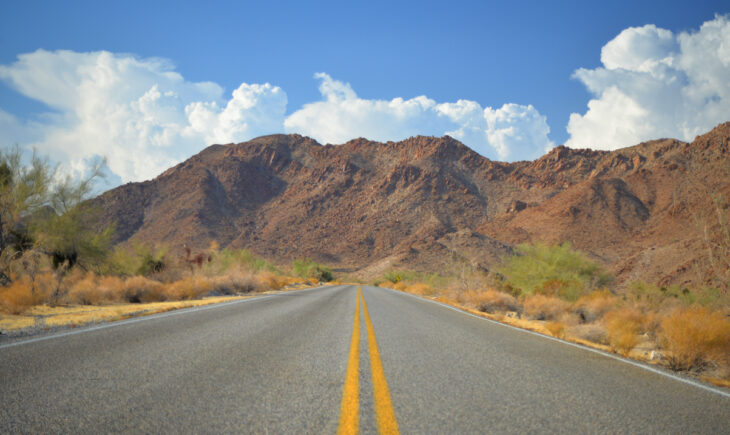Joshua Tree National Park is located within the desert inland of southeastern California. The land actually encompasses two different desert ecosystems. One of these is the Mojave Desert, the driest desert and landscape in North America, whose region and boundaries are determined by its indicator species: Joshua Trees, which only reside in the Mojave Desert. Connected to the Mojave Desert, but at a lower altitude is the Colorado Desert. It is noted for its abundance of scrub brush. Within Joshua Tree National Park, in the desolation of its southern portion, lies Cottonwood Springs Road. It passes through an opening in the rugged ridges that was carved by meager water flow over the course of millennia and drops rapidly in altitude into the lower Colorado Desert. Here the Wild Images Team captured a photo of Cottonwood Springs road near the passage through the rugged cliffs. This region lies within the Colorado desert, hence the lack of any Joshua trees but plenty of colorful scrub brush and equally colorful desolate ridges. Ahead lies the ascent into the Mojave Desert and its Joshua trees; behind the land descends into the valley where the road meets I-10 at a cloverleaf intersection devoid of any human structures besides the road. The Wild Images Team has captured many other photos from California such as the scene of a blooming thunderstorm over Joshua Tree National Park, the lava flow created streaked ridge in Lassen Volcanic National Park, and the high altitudes where a giant sequoia is larger and redder than others, the steep Hyde Street view of Alcatraz Island and San Francisco Bay, the drastic slope of the abrupt drop off of Taylor Street, the Pine Street colorful terraced houses with background buildings, the historic looking beautiful terraced houses and a Classic VW Beetle, and the Asian inspired intricately ornate Chinatown scene, each of which are available for sale in our store. Blog posts from California have documented the long and winding road climb to the giants of Sequoia National Park, the size comparison of The Wild Images Team Coordinator Christina and the giant tree, the massive view where giant sequoias maintain their diameters over hundreds of feet, an overlook into the Merced River Valley with Liberty Cap, the road heading towards the sheer monolith of El Capitan, the road heading towards desolate ridges of Joshua Tree National Park, the location where the road rises out of Bumpass Hell, a beach dune covered view of the secret underground World War II bunker, the reflective tower of the Marriott Marquis over the Yerba Buena Gardens, the distinctively ornate Asian architecture and decor of Chinatown, the musically inspired melting records with album covers mural, the long strange trip of the Grateful Dead Jerry Garcia mural, the places where steep sidewalks have stairs cut into them, the street where a tree gives a sense of the steepness, the expansive view of Nob Hill from Telegraph Hill and the oppositely directed view from Telegraph Hill to the northeast, the descent in the upper portion of the Filbert Steps, followed by the middle portion of the Filbert Steps with a pose by The Wild Images Team Coordinator on the steps, followed by the lower portion of the Filbert Steps, and at the bottom a view up the Filbert Street steps again with a pose by The Wild Images Team Coordinator below the steps. From our travels in the nearby Oregon and Washington, we have captured photos such as the deep blue hues of swirled clouds and rim peaks reflected in Crater Lake, the Hoh Rainforest green moss covers every possible branch, and the right place at the right time rainbow over the Mt. St. Helens remnants, each of which are available for sale in our store. Blog posts from Oregon and Washington include the sharp looking view through the Lava Cast Forest, the optical illusion of blue waters and white streaks in Crater Lake, the starkly colorful rainbow rises over the devastation of Mt. St. Helens, the moment The Wild Images Team Coordinator Christina is imprisoned by rainforest tree roots, the interesting story of the Port Angeles waterfront Rocktopus Sculpture, and its accompanying bronze plaque of charitable organizations.
To see more photos, please visit our store


